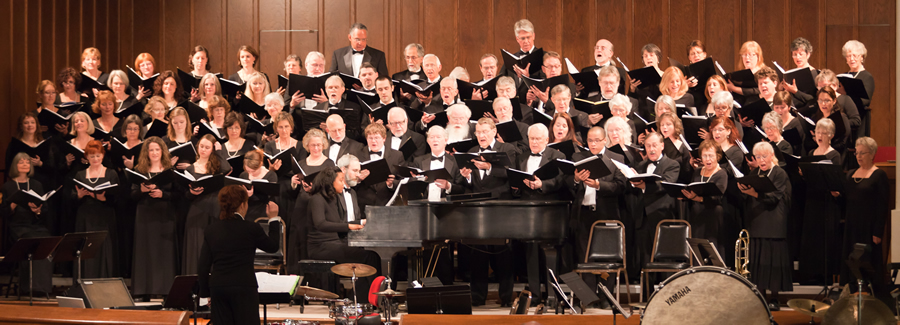The Asheville Choral Society‘s holiday concert at Asheville’s First Baptist Church took on special meaning this year as a fundraiser for the Asheville area’s Habitat for Humanity. Building quality and affordable housing for deserving families in need, this organization has managed to help 250 local families; the latest recipients were the guests of honor. Hearing the family speak of their gratitude at a pause in the concert, and seeing slides of other Habitat works in progress, underscored the need for this program here and elsewhere. For this event Director Melodie Galloway programmed carols from the distant past and in contemporary arrangements, along with a single multi-movement cantata, Stella Natalis, by Karl Jenkins, which also utilized the children of Celebration Singers of Asheville (Ginger Haselden, Director). The assisting musicians were a trio of percussionists (Matthew Richmond and 2 unidentified), trumpet (Casey Coppenbarger), flute and recorder (Sabrina Kumar), a bassist (also unidentified), and piano/synthesizer (Brad Curtioff).
The Choral Society is a large, community-based, auditioned ensemble. For this concert there were close to 100 singers, the overwhelming majority of them female. The placement of the men in the center of the ensemble maximized their presence but couldn’t rectify the choral imbalance. Nonetheless, the men had their own moment in the sun with the novelty number “O Christmas Tree???” by Carl J. Nygard, Jr., about the idiocy of singing to a pine tree. This sense of fun permeated many other pieces on the concert. The sense of sheer delight in singing was evident in all the evening’s music making, and in the actions of Dr. Galloway, who frequently spoke from the podium.
The concert opener was “Patapan,” a traditional song from Burgundian France. In this attractive arrangement by Troy Robertson, an exotic flute melody with finger cymbals and hand drum provided the instrumental color to this well-known melody. Next was “Winter Solstice Carol” by William Beckstrand, its text by Giles Swayne about the cold (humorously at odds with the 70-degree temperature outside) contained a Latin text sung by a smaller group. Though the work was written for accompanying hand bells, all the bell parts worked extremely well on a single vibraphone.
“A ‘Soalin'”(arr. Paul Stookey, Tracy Batteast, Elena Mazzetti, and Ronald Staheli) is best known as the arrangement of three songs, “Hey Ho, Nobody Home,” “The Souling Song,” and “God Rest You Merry, Gentlemen” made famous in the 1960s recording by Peter, Paul, and Mary. A fourth song, “Here We Come A-wassailing,” also emerges in this arrangement. The songs become intertwined and reworked in quodlibet fashion due to the interchangeability of the harmonies of each. I must admit it’s hard to get an iconic recording out of one’s head when hearing it performed, and I found the tempo of this performance extremely slow, rendering the affect, especially of the portions of the Wassail song in the major key, unduly ponderous. Following this, Brad Curtioff showcased his talents as both pianist and arranger in his jazzy, smoky-stylized version for solo piano of “Silent Night.”
At the heart of this program was Stella Natalis (2009), a captivating work in 12 movements by Jenkins (b.1944), a British composer who has been extremely active in composing for commercial enterprises (Levi’s, British Airways, etc.) as well as traditional classical genres (concertos, works for choirs, songs, etc.). Stella Natalis bears an eclectic mixture of cross-over styles unique to this composer – commercial, classical writing, and world-music influenced elements. His fearlessness in experimenting with language (incorporating non-sense syllables, or words of his own making) and juxtaposing disparate musical elements in unlikely and often startling combinations were defining features of this work, probably never performed before in Asheville. Lasting nearly 50 minutes, this was an ambitious work by any measure, and the performance, while not perfect, was admirable for its careful attention to the details of style within each movement. Unfortunately time and space do not allow me to describe all the fascinating details revealed in this performance, but several movements were exemplary. “Lullay” featured the children’s choir, which sang in beautiful intonation and diction, accompanied by solo trumpet and soprano recorder. The following “Cantus triquetus – The triangle song” was Jenkins at his quirkiest – riffs in the text on the concept of 3 (“many things come in threes,” including the ubiquitous 3-sided triangle that jangled throughout) which the choir tossed off with abandon. The humorous “Wintertide,” frequently in a meter of 7, playfully stuttered with the cold, distilling at the end to a slower, hypnotic uttering of “icy cold” again and again. Soprano Tabitha Judy was the magnificent soloist in “Only Heavenly Music,” where her crystalline voice soared to its highest note taxingly at the very end, and “Make we merry,” humorously requiring of her again and again to execute an ascending scale to the very heights. “Sing with joy at Christmas” featured the exceptional talents of young Celebration Singers Hannah Kepple and Hayden Strickler who already sing with a professional caliber of clarity and poise.
The concert ended with a sentimental favorite, John Rutter’s “I Wish You Christmas” sung with all the warm, full sound the choir could muster. While the audience clearly loved this accessible piece, I deeply appreciated the enormous variety of this program and the work that must have gone into preparing it. Bravo tutti!











